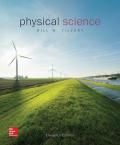
Concept explainers
(a)
The mass percentage composition of K, C and O in potash,
(a)
Answer to Problem 3PEB
Solution:
Percentage composition of K, C and Oin
Explanation of Solution
Given data:
Atomic mass ofC = 12 u.
Atomic mass of O = 16 u.
Formula used:
Explanation:
Step 1: To calculate the formula weight of
In
Step 2: To calculate the percentage composition.
Conclusion:
Percentage composition of K, C and Oin
Potassium has the highest percentage composition and carbon has the least.
(b)
The mass percentage composition of Ca, S and O in gypsum,
(b)
Answer to Problem 3PEB
Solution:
Percentage composition of Ca, S and Oin
Explanation of Solution
Given data:
Atomic mass ofCa = 40.1 u.
Atomic mass ofS = 32.1 u.
Atomic mass of O = 16 u.
Formula used:
Explanation:
Step 1: To calculate the formula weight of
In
Step 2: To calculate the percentage composition.
Conclusion:
Percentage composition of Ca, S and Oin
Oxygen has the highest percentage composition and sulphur has the least.
(c)
The mass percentage composition of K, N and O in gypsum,
(c)
Answer to Problem 3PEB
Solution:
Percentage composition of K, N and Oin
Explanation of Solution
Given data:
Atomic mass ofK = 39.1 u.
Atomic mass ofN = 14 u.
Atomic mass of O = 16 u.
Formula used:
Explanation:
Step 1: To calculate the formula weight of
In
Step 2: To calculate the percentage composition.
Conclusion:
Percentage composition of K, N and Oin
Oxygen has the highest percentage composition and potassium has the least.
(d)
The mass percentage composition of C, H, N and O in gypsum,
(d)
Answer to Problem 3PEB
Solution:
Percentage composition of C, H, N and Oin
Explanation of Solution
Given data:
Atomic mass ofC = 12 u.
Atomic mass of H = 1 u.
Atomic mass of N = 14 u.
Atomic mass of O = 16 u.
Formula used:
Explanation:
Step 1: To calculate the formula weight of
In
Step 2: To calculate the percentage composition.
Conclusion:
Percentage composition of C, H, N and O in
Want to see more full solutions like this?
Chapter 10 Solutions
EBK PHYSICAL SCIENCE
- A capacitor with a capacitance of C = 5.95×10−5 F is charged by connecting it to a 12.5 −V battery. The capacitor is then disconnected from the battery and connected across an inductor with an inductance of L = 1.55 H . At the time 2.35×10−2 s after the connection to the inductor is made, what is the current in the inductor? At that time, how much electrical energy is stored in the inductor?arrow_forwardCan someone help me with this question. Thanks.arrow_forwardCan someone help me with this question. Thanks.arrow_forward
 An Introduction to Physical SciencePhysicsISBN:9781305079137Author:James Shipman, Jerry D. Wilson, Charles A. Higgins, Omar TorresPublisher:Cengage Learning
An Introduction to Physical SciencePhysicsISBN:9781305079137Author:James Shipman, Jerry D. Wilson, Charles A. Higgins, Omar TorresPublisher:Cengage Learning
 Physics for Scientists and Engineers, Technology ...PhysicsISBN:9781305116399Author:Raymond A. Serway, John W. JewettPublisher:Cengage Learning
Physics for Scientists and Engineers, Technology ...PhysicsISBN:9781305116399Author:Raymond A. Serway, John W. JewettPublisher:Cengage Learning University Physics Volume 3PhysicsISBN:9781938168185Author:William Moebs, Jeff SannyPublisher:OpenStax
University Physics Volume 3PhysicsISBN:9781938168185Author:William Moebs, Jeff SannyPublisher:OpenStax College PhysicsPhysicsISBN:9781938168000Author:Paul Peter Urone, Roger HinrichsPublisher:OpenStax College
College PhysicsPhysicsISBN:9781938168000Author:Paul Peter Urone, Roger HinrichsPublisher:OpenStax College





